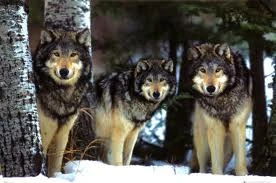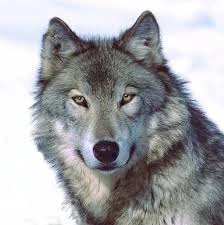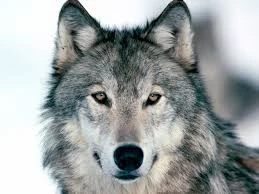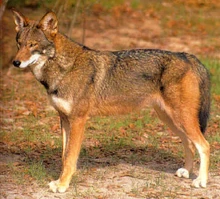(Adding categories) Tag: categoryselect |
mNo edit summary Tags: Visual edit apiedit |
||
| Line 1: | Line 1: | ||
[[File:Wolves.jpg|thumb|276px|right|A small wolf pack.]] |
[[File:Wolves.jpg|thumb|276px|right|A small wolf pack.]] |
||
| − | [[File:Humphrey_in_real_life.jpg|thumb|276px|right| The Canis Lupus.]] |
+ | [[File:A_Gray_Wolf..jpg|thumb|276px|right| The Gray Wolf.]][[File:Humphrey_in_real_life.jpg|thumb|276px|right| The Canis Lupus.]] |
| − | [[File:A_Gray_Wolf..jpg|thumb|276px|right| The Gray Wolf.]] |
||
| − | |||
==Wolves== |
==Wolves== |
||
| − | The '''gray wolf''' or '''grey wolf''' (Canis Lupus) is a canine native to the wilderness and remote areas of North America, Eurasia, and North Africa. It is the largest member of its family, with males averaging 43–45 kg (95–99 lb), and females 36–38.5 kg (79–85 lb). It is similar in general appearance and proportions to a German shepherd, or sled dog, but has |
+ | The '''gray wolf''' or '''[https://en.wikipedia.org/wiki/Gray_wolf grey wolf]''' (Canis Lupus) is a canine native to the wilderness and remote areas of North America, Eurasia, and North Africa. It is the largest member of its family, with males averaging 43–45 kg (95–99 lb), and females 36–38.5 kg (79–85 lb). It is similar in general appearance and proportions to a German shepherd, or sled dog, but has |
| + | |||
| + | a larger head, narrower chest, longer legs, straighter tail, and bigger paws. Its winter fur is long and bushy, and predominantly a mottled gray in colour, although nearly pure white, red, or brown to black also occur. |
||
Within the genus Canis, the gray wolf represents a more specialised and progressive form than its smaller cousins (the coyote and golden jackal), as demonstrated by its morphological adaptations to hunting large prey, its more gregarious nature, and its highly advanced expressive behavior. It is a social animal, travelling in nuclear families consisting of a mated pair, accompanied by the pair's adult offspring. The gray wolf is typically an apex predator throughout its range, with only humans and tigers posing a serious threat to it. It feeds primarily on large ungulates, though it also eats smaller animals, livestock, carrion, and garbage. |
Within the genus Canis, the gray wolf represents a more specialised and progressive form than its smaller cousins (the coyote and golden jackal), as demonstrated by its morphological adaptations to hunting large prey, its more gregarious nature, and its highly advanced expressive behavior. It is a social animal, travelling in nuclear families consisting of a mated pair, accompanied by the pair's adult offspring. The gray wolf is typically an apex predator throughout its range, with only humans and tigers posing a serious threat to it. It feeds primarily on large ungulates, though it also eats smaller animals, livestock, carrion, and garbage. |
||
The gray wolf is one of the world's most well known and well researched animals, with probably more books written about it than any other wildlife species. It has a long history of association with humans, having been despised and hunted in most agricultural communities due to its attacks on livestock, while conversely being respected by some Native American tribes. It is the sole ancestor of the domestic dog(Canis Lupus Familiaris), which was first domesticated in the Middle East. Although the fear of wolves is prevalent in many human societies, the majority of recorded attacks on people have been attributed to animals suffering from rabies. Non-rabid wolves have attacked and killed people, mainly children, but this is unusual, as wolves are relatively few, live away from people, and have been taught to fear humans by hunters and shepherds. Hunting and trapping has reduced the species' range to about one third of its original range, though its still relatively widespread range and stable population means that the species is not threatened at a global level, and is therefore classified by the IUCN as Least Concern. |
The gray wolf is one of the world's most well known and well researched animals, with probably more books written about it than any other wildlife species. It has a long history of association with humans, having been despised and hunted in most agricultural communities due to its attacks on livestock, while conversely being respected by some Native American tribes. It is the sole ancestor of the domestic dog(Canis Lupus Familiaris), which was first domesticated in the Middle East. Although the fear of wolves is prevalent in many human societies, the majority of recorded attacks on people have been attributed to animals suffering from rabies. Non-rabid wolves have attacked and killed people, mainly children, but this is unusual, as wolves are relatively few, live away from people, and have been taught to fear humans by hunters and shepherds. Hunting and trapping has reduced the species' range to about one third of its original range, though its still relatively widespread range and stable population means that the species is not threatened at a global level, and is therefore classified by the IUCN as Least Concern. |
||
==Trivia== |
==Trivia== |
||
| + | [[File:Red Wolf.jpg|thumb|220x220px]] |
||
*The Red Wolf (Canis Rufus )is an endangered species. |
*The Red Wolf (Canis Rufus )is an endangered species. |
||
[[Category:Wolves]] |
[[Category:Wolves]] |
||
Revision as of 17:10, 5 February 2017

A small wolf pack.

The Gray Wolf.

The Canis Lupus.
Wolves
The gray wolf or grey wolf (Canis Lupus) is a canine native to the wilderness and remote areas of North America, Eurasia, and North Africa. It is the largest member of its family, with males averaging 43–45 kg (95–99 lb), and females 36–38.5 kg (79–85 lb). It is similar in general appearance and proportions to a German shepherd, or sled dog, but has
a larger head, narrower chest, longer legs, straighter tail, and bigger paws. Its winter fur is long and bushy, and predominantly a mottled gray in colour, although nearly pure white, red, or brown to black also occur. Within the genus Canis, the gray wolf represents a more specialised and progressive form than its smaller cousins (the coyote and golden jackal), as demonstrated by its morphological adaptations to hunting large prey, its more gregarious nature, and its highly advanced expressive behavior. It is a social animal, travelling in nuclear families consisting of a mated pair, accompanied by the pair's adult offspring. The gray wolf is typically an apex predator throughout its range, with only humans and tigers posing a serious threat to it. It feeds primarily on large ungulates, though it also eats smaller animals, livestock, carrion, and garbage. The gray wolf is one of the world's most well known and well researched animals, with probably more books written about it than any other wildlife species. It has a long history of association with humans, having been despised and hunted in most agricultural communities due to its attacks on livestock, while conversely being respected by some Native American tribes. It is the sole ancestor of the domestic dog(Canis Lupus Familiaris), which was first domesticated in the Middle East. Although the fear of wolves is prevalent in many human societies, the majority of recorded attacks on people have been attributed to animals suffering from rabies. Non-rabid wolves have attacked and killed people, mainly children, but this is unusual, as wolves are relatively few, live away from people, and have been taught to fear humans by hunters and shepherds. Hunting and trapping has reduced the species' range to about one third of its original range, though its still relatively widespread range and stable population means that the species is not threatened at a global level, and is therefore classified by the IUCN as Least Concern.
Trivia

- The Red Wolf (Canis Rufus )is an endangered species.
